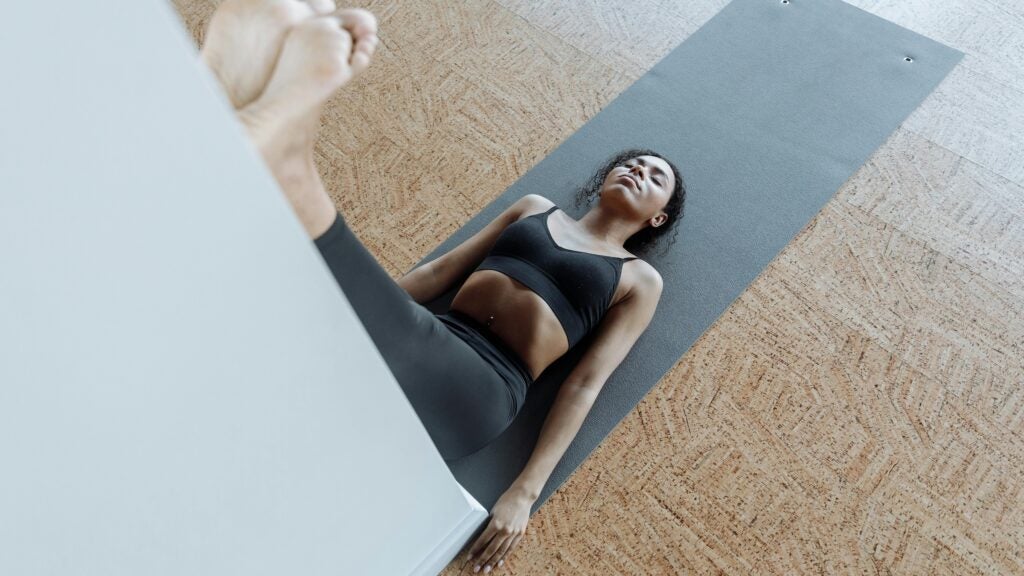“], “filter”: { “nextExceptions”: “img, blockquote, div”, “nextContainsExceptions”: “img, blockquote, a.btn, a.o-button”} }”>
Heading out the door? Read this article on the new Outside+ app available now on iOS devices for members!
>”,”name”:”in-content-cta”,”type”:”link”}}”>Download the app.
Your yoga practice helps you pursue ease of flow in your movement, your breathing, even your internal processes—and that includes your lymphatic system. The fluid in your lymphatic system wants to flow, but due to the natural mechanisms of the system and the possibility of disruptions or blockages can happen, it needs a little help from you.
By encouraging the flow of lymph fluid through the lymphatic system, you not only de-puff your face (and other body parts) but help boost your immunity and reduce undue inflammation.
“Keeping the lymphatic system clean and flowing is vital not only for aesthetic results but also for our overall health and immunity,” says Rebecca Faria, founder of LA-based lymphatic drainage spa Detox by Rebecca. “By prioritizing good nutrition, regular exercise, adequate hydration, and engaging in activities like stretching, yoga and rebounding, you support your body in naturally flushing out toxins and maintaining optimal lymphatic function.”
The Function of the Lymphatic System
The lymphatic system has three main functions: to maintain the body’s fluid balance, absorb fat from the gastrointestinal tract, and filter bacteria in support of our immune response, explains Kristen Krueger, board-certified clinical specialist at the Department of Physical Medicine and Rehabilitation at UC Davis Health.
“The lymphatic vessels travel through the body adjacent to the circulatory system and collect fluid waste from the area between tissues called the interstitial space,” says Krueger. “Through a network of vessels, organs, glands, and ducts it returns the filtered fluid to the circulatory system via the heart to be pumped out again.”
Krueger adds that there are two main ducts that collect lymph fluid from the smaller lymph vessels: the thoracic duct and the lymphatic duct. Together, the ducts and vessels work to collect, transport, and drain the body’s lymph fluid in a cyclical fashion.
When your lymphatic system is flowing properly, your fluids are balanced and your immune system is supported. “As lymph fluid flows through vessels, it passes through lymph nodes whose main function is to filter out harmful cells like bacteria, viruses, and cancer,” says Krueger.
More superficially, encouraging lymph movement rids your tissues of excess fluid, reducing swelling, inflammation, and water retention. “People feel lighter and more energized as toxins are flushed from the system, while improved circulation promotes healthier, more vibrant skin through better nutrient delivery and reduced congestion,” says Faria. “The healthier lifestyle you maintain, the less toxin buildup you’ll have in your body, making it easier for your lymphatic system to undergo the clearing-out process.”
Your heart pumps to keep your circulatory system in check, but your lymphatic system requires your effort to do its job. According to Krueger, a healthy lymphatic system flows in a predictable sequence that relies on muscle contraction and breathing, in addition to its own one-way valves, to flow as easily as your yoga practice.
Problems arise when the natural flow of this cycle is obstructed through blockages caused by bodily trauma, infection, and more. “This can result in a back-up of lymphatic fluid called lymphedema, which results in swelling and a feeling of heaviness in the affected limb or body region,” says Krueger.
There are several approaches to alleviating lymphatic buildup by moving the fluid toward the ducts, including lymphatic drainage massage, compression, and movement, including your yoga practice.
4 Ways to Use Yoga for Lymphatic Drainage
“By incorporating healthy practices into your daily routine, you can help your lymphatic system work more effectively and maintain better overall health,” says Faria. The following yoga mainstays feature targeted movements that can help get the lymph moving.
1. Belly Breathing
According to Krueger, deep breathing can directly benefit your lymphatic system. “Practicing diaphragmatic or ‘belly’ breathing puts increased pressure on the thoracic duct and helps push lymph fluid from the lower body, pelvis, and abdomen up toward the left subclavian vein before it drains to the heart,” she explains.
2. Vinyasa
Movement of all kinds moves lymph, making vinyasa yoga an almost foolproof method of fostering flow. “When muscles contract, they increase the pressure around the lymphatics which pushes the lymph fluid and sustains the flow,” says Krueger. Regular vinyasa practice can also improve your posture, which eases lymphatic congestion and deepening your breathing.
3. Inverted Poses
Inversions such as Bridge Pose, Legs Up the Wall, and Wheel Pose encourage your body’s fluids to flow freely by leveraging gravity to move lymph fluid toward the heart. This can help alleviate swelling and water retention in the limbs.
4. Yin Yoga
In addition to more active movement and yoga practices, Krueger notes that sustained positions can also benefit the lymphatic system. Yin yoga’s long holds and muscle contractions access deeper levels of fascia and can help stimulate lymphatic circulation while also promoting relaxation, flexibility, and vitality.

